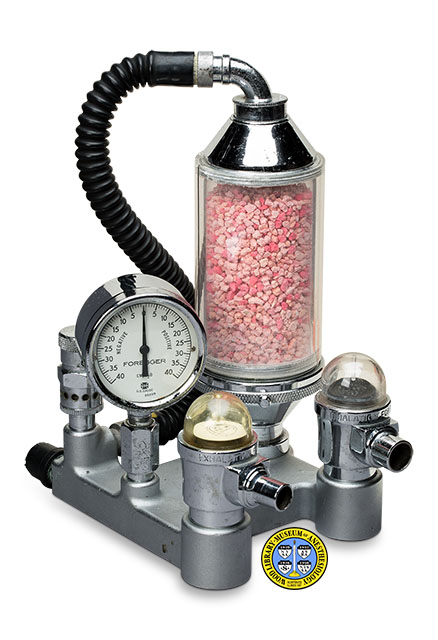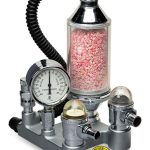Bloomquist Infant Circle Absorber
In a "closed" anesthesia breathing circuit, an absorber filled with soda lime removes the patient's exhaled carbon dioxide (CO2). The addition of oxygen then allows the patient to rebreathe his own air. Carbon dioxide absorbers were popularized in the 1920s. Since the 1940s, chemical agents have been added to the soda lime which cause it to turn color (from white to either pink, or blue) when it can absorb no more CO2. Transparent canisters came into use at the same time. One of the first CO2 absorbers made for pediatric patients, the Ohio Model 60, was introduced in 1954.
In 1957, Edward R. Bloomquist, M.D. , described his own infant circle absorber. Made by Ohio's competitor, the Foregger Company of New York, it appeared in catalogs from 1958 through 1962. Foregger introduced a new design in 1965. The Modified Bloomquist was equipped with inspiration and expiration valves, and a pressure gauge, like those in Ohio's Model 60. The Modified Bloomquist, shown here, was offered by Foregger through 1978. The complete apparatus included a rubber mask, rebreathing bag, additional hoses and other parts. Breathing systems of this generation were replaced during the 1970s with improved technology.
Catalog Record: Bloomquist Infant Circle Absorber Bloomquist Infant Circle Absorber
Access Key: aqsj
Accession No.: 2014-01-24-1
Title: [Modified Bloomquist Infant Circle Absorber] / Foregger Company.
Corporate Author: Foregger Company.
Physical Description: 1 carbon dioxide absorber : metals (including aluminum), plastics, rubber, glass ; 26 x 18 x 22 cm.
Subject: Anesthesia, Closed-Circuit.
Subject: Anesthesia, Pediatric – instrumentation.
Subject: Carbon Dioxide Absorbers.
Subject: Respiration – instrumentation.
Note Type: General
Notes: The first year in the range of possible dates of manufacture is based on the date of introduction. The second year in the date range is based on the pricelist dated April, 1962, which states that the apparatus has been discontinued.
Described with the gauge and pop-up valves facing forward.
As received and photographed, the canister was filled with pink soda lime. The soda lime should be disposed of in accordance with hazardous waste regulations.
Note Type: Citation
Notes: Bloomquist ER. A “Y” adapter for open system intubation anesthesia. Anesthesiology. November, 1953;14(6):618-619.
Note Type: Citation
Notes: Bloomquist ER. Pediatric circle absorber. Anesthesiology. September-October, 1957;18(5):787-789.
Note Type: Citation
Notes: Foregger Company. Catalog 15: Anesthesia Apparatus. New York: The Foregger Company, 1958:52.
Note Type: Citation
Notes: Foregger Company. Catalog 17: Anesthesia Apparatus. New York: The Foregger Company, 1962:22.
Note Type: Citation
Notes: Foregger Company File. Archives. Located at: Wood Library-Museum of Anesthesiology, Schaumburg, Illinois.
Note Type: Citation
Notes: Hale DE. The rise and fall of soda lime. Anesthesia and Analgesia. September-October 1967;46(5):646-648.
Note Type: Citation
Notes: Ramanathan S, Chalon J, Turndorf JH. Humidity output of the Bloomquist infant circle. Anesthesiology. December, 1975;43(6):679-682.
Note Type: Citation
Notes: Roffey PJ, Revell DG, Morris LD. An assessment of the Revell circulator. Anesthesiology. July-August, 1961; 22(4): 583-590.
Note Type: Physical Description
Notes: One carbon dioxide absorber ; Consists of a H-shaped metal platform (called the “Plate Assembly”) on which the other components are mounted; The front edge of this platform holds two pop-off valves, each with a transparent plastic dome; That valve on the left is marked: “EXHALATION FOREGGER”; That valve on the right is marked “INHALATION FOREGGER”
A pressure gauge is mounted on the platform behind the exhalation valve; This face of this gauge is turned somewhat to the left; The gauge is marked, from left to right: “NEGATIVE [new line] 40, 35, 30. 25. 20. 15. 5. 0 [new line] POSITIVE [new line] 5, 10, 15. 20, 25, 30, 35, 40″; [new line] FOREGGER [new line] CM / H2O [new line] U. S. GAUGE [new line] 26209”; Another pop-off valve is mounted behind the gauge;
A transparent plastic canister is mounted on the platform behind the inhalation valve; This canister is connected to the rear pop-off valve by a corrugated black rubber hose; As received and photographed, the canister was filled with exhausted soda lime (as indicated by its pink color).
Note Type: Acquisition
Notes: Gift of Robert I. Shrier, M.D.
Note Type: Historical
Notes: In a “circle” breathing system the gases literally travel in a circle through a series of tubes, connections, valves and other apparatus. This breathing system was also used as a “closed” system, meaning it allowed for total rebreathing of exhaled gases. To follow the flow of gas through one rotation we would start where fresh anesthetic gas and oxygen are delivered from the anesthesia machine to the patient via an inspiratory tube. The patient’s exhaled breath is carried away in an expiratory tube. Next, CO2 is filtered out of the exhaled breath by an apparatus called an absorber so that oxygen and anesthetic gas not absorbed by the patient’s body can be sent back to the patient after being mixed with fresh gas. The amount of fresh gas and oxygen that is added only replaces what the patient’s body absorbed. Then, the rotation starts again.
The first popular carbon dioxide absorber was introduced in 1924 by Ralph Waters, M.D. (1883-1979). It consisted of a metal canister connected to a mask and other parts. Circle breathing was introduced in 1930 by Brian Sword, M.D. (1889-1956.) The absorber is filled with soda lime, a white gravel-like material that has the property of absorbing CO2. Since the 1940s, chemical agents have been added to the soda lime which cause it to turn color when it is exhausted (that is, when it can absorb no more CO2.) Absorbers with transparent canisters also came into use at that time. One of the first CO2 absorbers built for pediatric patients was the Ohio Model 60 Infant Circle Absorber, introduced around 1954 but not patented until 1958.
Edward R. Bloomquist, M.D. may be best known for his extensive writing on substance-related disorders. In 1957, he described his own infant circle absorber. Made by Ohio’s competitor, the Foregger Company of New York, this appeared in the manufacturer’s catalogs from 1958 through 1962. A new design was introduced around 1965. The Modified Bloomquist was equipped with inspiration and exhalation valves, and a pressure gauge, parts that were incorporated in the earlier Ohio Model 60. An undated Foregger brochure describes both the Modified and the original model, then called the “Standard”. The cataloged object is an example of the Modified absorber, offered by Foregger through 1978. When complete, the absorber was accompanied by a mask, rebreathing bag, additional hoses and other parts.
Note Type: Publication
Notes: Bloomquist ER. From G. P. to anesthesiologist. Medical Times. November 1956;84(11):1273-1278.
Note Type: Exhibition
Notes: Selected for the WLM website.


